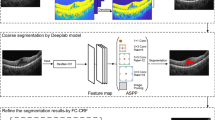Abstract
Macular Edema (ME) is the accumulation of fluid in the macular region of the eye, and it may lead to the distortion of center vision. It often occurs in diabetic retinopathy. It is important to measure fluid accumulation in ME patients for disease monitor. Segmentation of the fluid region in the retinal layer is an essential step for quantitatively analysis. However, manual segmentation is time consuming and also subjective. In this paper, a new deep learning based segmentation method is proposed. The attention mechanism is introduced to automatically locate the fluid region, which can reduce the number of parameters compared to typical two-stage approaches. In addition, dense skip connection makes the segmentation result more accurate. Joint losses are used, including cross entropy loss, dice loss and regression loss. The proposed method is evaluated on a public available dataset, results show that the proposed method can adapt to the OCT scans acquired by various imaging scanning devices, and this method is more effective than other methods.
Access this chapter
Tax calculation will be finalised at checkout
Purchases are for personal use only
Similar content being viewed by others
References
Marmor, M.F.: Mechanisms of fluid accumulation in retinal edema. In: Wolfensberger, T.J. (ed.) Macular Edema, pp. 35–45. Springer, Heidelberg (2000). https://doi.org/10.1007/978-94-011-4152-9_4
Roychowdhury, S., Koozekanani, D.D., Radwan, S., Parhi, K.K.: Automated localization of cysts in diabetic macular edema using optical coherence tomography images. In: International Conference of the IEEE Engineering in Medicine and Biology Society, vol. 2013, pp. 1426–1429 (2013)
Wilkins, G.R., Houghton, O.M., Oldenburg, A.L.: Automated segmentation of intraretinal cystoid fluid in optical coherence tomography. IEEE Trans. Biomed. Eng. 59(4), 1109–1114 (2012)
Liu, X., Liu, D., Fu, T., Pan, Z., Hu, W., Zhang, K.: Shortest path with backtracking based automatic layer segmentation in pathological retinal optical coherence tomography images. In: Multimedia Tools and Applications, pp. 1–22 (2018)
Pilch, M., et al.: Automated segmentation of pathological cavities in optical coherence tomography scans. Investig. Ophthalmol. Vis. Sci. 54(6), 4385–4393 (2013)
Lang, A., et al.: Automatic segmentation of microcystic macular edema in OCT. Biomed. Opt. Express 6(1), 155–169 (2015)
Chiu, S.J., Allingham, M.J., Mettu, P.S., Cousins, S.W., Izatt, J.A., Farsiu, S.: Kernel regression based segmentation of optical coherence tomography images with diabetic macular edema. Biomed. Opt. Express 6(4), 1172–1194 (2015)
Liu, X., et al.: Automated layer segmentation of retinal optical coherence tomography images using a deep feature enhanced structured random forests classifier. IEEE J. Biomed. Health Inform. PP(99) (2018)
Liu, X., et al.: Semi-supervised automatic segmentation of layer and fluid region in retinal optical coherence tomography images using adversarial learning. IEEE Access 7, 3046–3061 (2019)
Liu, D., Liu, X., Fu, T., Yang, Z.: Fluid region segmentation in OCT images based on convolution neural network. In: Ninth International Conference on Digital Image Processing (ICDIP 2017), vol. 10420, p. 104202A. International Society for Optics and Photonics (2017)
Lee, A.Y., Rokem, A., Tyring, A.J., Lee, C.S., Deruyter, N.P., Wu, Y.: Deep-learning based, automated segmentation of macular edema in optical coherence tomography. Biomed. Opt. Express 8(7), 3440 (2017)
Schlegl, T., et al.: Fully automated detection and quantification of macular fluid in OCT using deep learning. Ophthalmology 125(4), S0161642017314240 (2017)
Venhuizen, F.G., et al.: Deep learning approach for the detection and quantification of intraretinal cystoid fluid in multivendor optical coherence tomography. Biomed. Opt. Express 9(4), 1545 (2018)
Lin, G., Milan, A., Shen, C., Reid, I.: RefineNet: multi-path refinement networks with identity mappings for high-resolution semantic segmentation (2016)
Bahdanau, D., Cho, K., Bengio, Y.: Neural machine translation by jointly learning to align and translate. In: ICLR (2015)
Luong, T., Pham, H., Manning, C.D.: Effective approaches to attention-based neural machine translation. In: Proceedings of the 2015 Conference on Empirical Methods in Natural Language Processing, pp. 1412–1421 (2015)
Milletari, F., Navab, N., Ahmadi, S.A.: V-Net: fully convolutional neural networks for volumetric medical image segmentation. In: Fourth International Conference on 3D Vision, pp. 565–571 (2016)
Naylor, P., Laé, M., Reyal, F., Walter, T.: Segmentation of nuclei in histopathology images by deep regression of the distance map. IEEE Trans. Med. Imaging 38(2), 448–459 (2019)
Wu, J., et al.: Multivendor spectral-domain optical coherence tomography dataset, observer annotation performance evaluation, and standardized evaluation framework for intraretinal cystoid fluid segmentation. J. Ophthalmol. 2016, 1–8 (2016)
Acknowledgment
This work is partially supported by the National Natural Science Foundation of China (No. 61403287, No. 61472293, No. 61572381), and the Natural Science Foundation of Hubei Province (No. 2014CFB288).
Author information
Authors and Affiliations
Corresponding author
Editor information
Editors and Affiliations
Rights and permissions
Copyright information
© 2019 Springer Nature Switzerland AG
About this paper
Cite this paper
Liu, X., Liu, D., Li, B., Wang, S. (2019). Deep Learning Based Fluid Segmentation in Retinal Optical Coherence Tomography Images. In: Huang, DS., Bevilacqua, V., Premaratne, P. (eds) Intelligent Computing Theories and Application. ICIC 2019. Lecture Notes in Computer Science(), vol 11643. Springer, Cham. https://doi.org/10.1007/978-3-030-26763-6_33
Download citation
DOI: https://doi.org/10.1007/978-3-030-26763-6_33
Published:
Publisher Name: Springer, Cham
Print ISBN: 978-3-030-26762-9
Online ISBN: 978-3-030-26763-6
eBook Packages: Computer ScienceComputer Science (R0)




